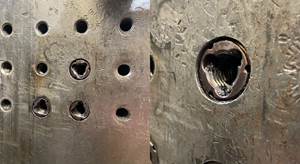Rubbery, Velvety, Silky: Properties of Coated Auto Plastic Parts
HapticMapping is an objective approach for determining the haptic properties of PUR-coated plastics.

The coating of interior automotive plastic components to improve appearance, physical properties and to impart the unique soft feel also referred to as haptic feel, has been taking place for some time. However, a key challenge in developing haptic coatings has been the subjective nature of judging the feel of haptic ranges referred to as rubbery, velvety and silky. Coating formulators have been seeking a balance between the desired softness and the resin properties needed to protect the plastic substrate and also meet interior designers’ requirements.
Scientists at Covestro LLC have aimed to remedy the challenge of being able to effectively balance the haptic properties polyurethane (PUR) coatings with their other performance properties—most notably, chemical resistance. This, through the development of objective test methodology, HapticMapping which rates the coated substrates by feel and numerical quantification.
The company used a Design of Experiment (DOE) approach to map haptic feel of PUR-coated plastics substrates against coating performance targets, explains Kurt Best, senior principal scientist, at Covestro’s Coatings, Adhesives & Specialties business segment.
The initial coating feel ratings were obtained via a survey of people knowledgeable in soft-feel coating applications. These data were then correlated with polymer physics analysis test data that included surface friction and micro-indenter measurements.
The results reportedly yield a coating formulation space for hundreds of potential coating formulations for solvent and waterborne 2K polyurethane coatings and their predicted haptic feel rating overlaid with performance properties.
To quantify haptic feel, two feel standards and two commercial coatings were benchmarked using the traditional feel survey and the quantitative methods the researchers appplied. These values were then averaged to determine ranges and used as reference point to develop a waterborne coating with similar properties.
The Covestro researchers’ haptic model uses four quantified measurements as follows:
● Coefficient of friction (CoF): This is a sensory measurement—CoF or surface drag. The test is used to simulate the force exerted by the coating when a light weight is slid down the coated surface of a test panel. The weight is placed on the coating and the test panel is raised on an incline until the weight starts to slide down the pane. The height of the incline is measured in centimeters. Measuring interior benchmark coatings, the results typically show 4.5 to 6.5 cm of incline when CoF is measured with this test. The measurement suggests that increasing the CoF increases the perception of softness.
● Polymer Deformation: This measurement is best described as a polymer compression and recovery function. It correlates with micro-hardness and can be used to predict the chemical performance of the coating. Positive numbers define a softer polymer matrix that is more susceptible to chemical attack and degradation. As the polymer deformation number becomes negative, the coating becomes harder and properties like scratch and chemical resistance improve.
● Micro-Hardness: This requires taking three measurements from the polymer surface using a micro-indenter. The depth of the measurement is restricted to the first 5-6 microns of the coating’s surface, thereby minimizing possible substrate influences.
● Modulus: This is a dominating measurement which helps define the other properties in the haptic model, and is measured with the micro-indenter and reported in mega Pascal (MPa). Modulus correlates to the CoF, micro-hardness, and polymer deformation, referring back to the benchmarking panels, the modulus range for interior coatings is between 30 and 60 MPa.
Says Best, “Similar to how a sound engineer has to balance and mix all the desired elements of a song, a formulator must balance soft touch with CoF, hardness, deformation and modulus values.” As shown in the chart, there is an overlap in each column measurement, but when comparing the various haptic feels there are differences in the quantified measurements.
HapticMapping allows for all the properties tested to be visualized, making it easier for the formulator to see the effect of resin changes on a given haptic formula and make adjustments accordingly, explains Best. In addition, HapticMapping will help quicker automotive OEM approvals by allowing the coating manufacturer to quickly assess and deliver coatings that achieve the balance between performance and feel.

Related Content
Molder Repairs Platen Holes with Threaded Inserts
Automotive molder ITW Deltar Fasteners found new life for the battered bolt holes on its machine platens with a solution that’s designed to last.
Read MoreInjection Molded Tape and Resin “Sandwich” Technology Debuts
During its Mobility Days in Austria, Engel and KTM Technologies debuted an all-plastic molded motorcycle seat base produced via a tape-sandwich process that can run in a standard molding process.
Read MoreImpacts of Auto’s Switch to Sustainability
Of all the trends you can see at NPE2024, this one is BIG. Not only is the auto industry transitioning to electrification but there are concerted efforts to modify the materials used, especially polymers, for interior applications.
Read MoreInjection Molded Enclosures Plug into Potential Electric Vehicle Battery Applications
In partnership with material suppliers, Engel is proving out injection molded thermoplastic-based concepts for electric vehicle battery housings, utilizing production tools and dedicated machines at its large press factory in St. Valentin, Austria.
Read MoreRead Next
See Recyclers Close the Loop on Trade Show Production Scrap at NPE2024
A collaboration between show organizer PLASTICS, recycler CPR and size reduction experts WEIMA and Conair recovered and recycled all production scrap at NPE2024.
Read MoreFor PLASTICS' CEO Seaholm, NPE to Shine Light on Sustainability Successes
With advocacy, communication and sustainability as three main pillars, Seaholm leads a trade association to NPE that ‘is more active today than we have ever been.’
Read MoreMaking the Circular Economy a Reality
Driven by brand owner demands and new worldwide legislation, the entire supply chain is working toward the shift to circularity, with some evidence the circular economy has already begun.
Read More


























